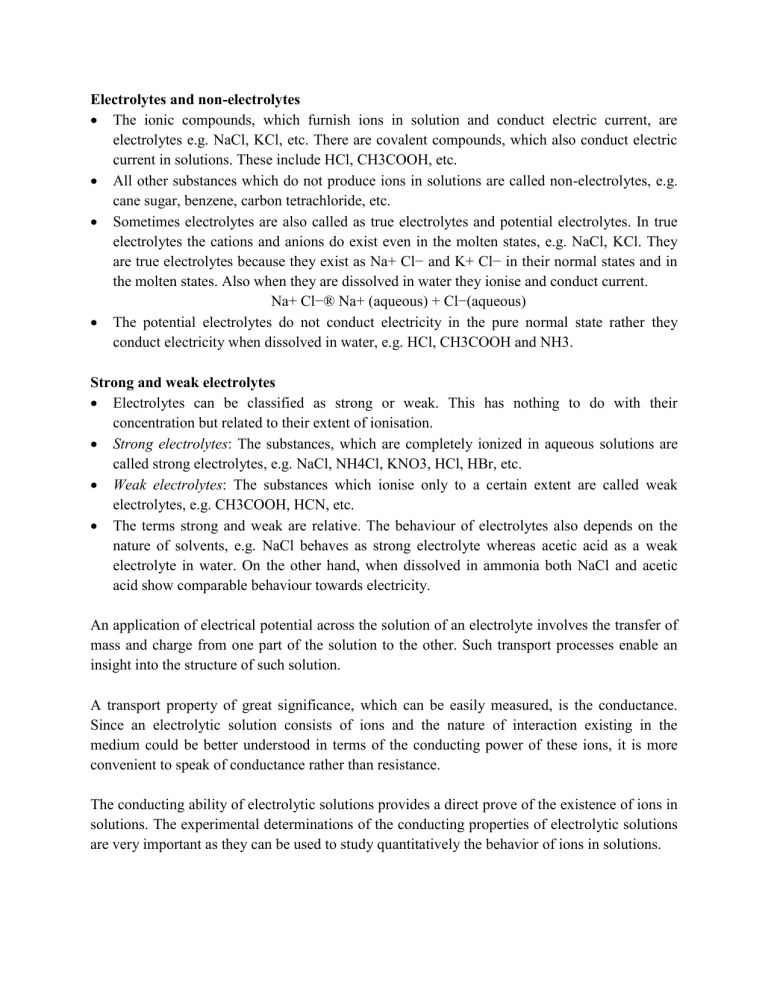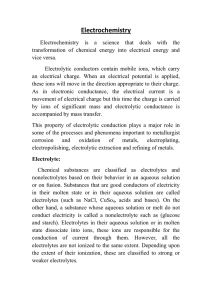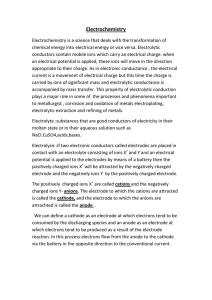
Electrolytes and non-electrolytes The ionic compounds, which furnish ions in solution and conduct electric current, are electrolytes e.g. NaCl, KCl, etc. There are covalent compounds, which also conduct electric current in solutions. These include HCl, CH3COOH, etc. All other substances which do not produce ions in solutions are called non-electrolytes, e.g. cane sugar, benzene, carbon tetrachloride, etc. Sometimes electrolytes are also called as true electrolytes and potential electrolytes. In true electrolytes the cations and anions do exist even in the molten states, e.g. NaCl, KCl. They are true electrolytes because they exist as Na+ Cl− and K+ Cl− in their normal states and in the molten states. Also when they are dissolved in water they ionise and conduct current. Na+ Cl−® Na+ (aqueous) + Cl−(aqueous) The potential electrolytes do not conduct electricity in the pure normal state rather they conduct electricity when dissolved in water, e.g. HCl, CH3COOH and NH3. Strong and weak electrolytes Electrolytes can be classified as strong or weak. This has nothing to do with their concentration but related to their extent of ionisation. Strong electrolytes: The substances, which are completely ionized in aqueous solutions are called strong electrolytes, e.g. NaCl, NH4Cl, KNO3, HCl, HBr, etc. Weak electrolytes: The substances which ionise only to a certain extent are called weak electrolytes, e.g. CH3COOH, HCN, etc. The terms strong and weak are relative. The behaviour of electrolytes also depends on the nature of solvents, e.g. NaCl behaves as strong electrolyte whereas acetic acid as a weak electrolyte in water. On the other hand, when dissolved in ammonia both NaCl and acetic acid show comparable behaviour towards electricity. An application of electrical potential across the solution of an electrolyte involves the transfer of mass and charge from one part of the solution to the other. Such transport processes enable an insight into the structure of such solution. A transport property of great significance, which can be easily measured, is the conductance. Since an electrolytic solution consists of ions and the nature of interaction existing in the medium could be better understood in terms of the conducting power of these ions, it is more convenient to speak of conductance rather than resistance. The conducting ability of electrolytic solutions provides a direct prove of the existence of ions in solutions. The experimental determinations of the conducting properties of electrolytic solutions are very important as they can be used to study quantitatively the behavior of ions in solutions. They can also be used to determine the values of many physical quantities such as solubilities and solubility product of sparingly soluble salts, ionic product of self ionizing solvents, hydrolysis constant of salts, dissociation constants of weak acids and bases and to form the basis for conductometric titration methods. Electrolytic conductance An electrolytic solution contains free ions in addition to other kinetically identifiable species. When electrical potential is applied across the solution the macroscopic observations are, the flow of current through the solution and the chemical changes generally resulting in the liberation or dissolution of the electrode material at the points where the current enters or leaves the solution. This phenomenon of decomposition of the solutions by electrical current is termed as electrolysis. Electrolytic conduction, in which charges carried by ions, will not occur unless the ions of the electrolyte are free to move. Hence, electrolytic conduction is exhibited principally by molten salts and by aqueous solutions of electrolytes. The principle of electrolytic conduction is best illustrated by reference to an electrolytic cell such as that shown in Fig. 4.1 for the electrolysis of molten NaCl between inert electrodes. The entire assembly except that of the external battery of Fig.4.1 is known as the cell. The electrons are received from the negative end of the external battery by the negative electrode of the cell. These are used up in the reduction reaction at this electrode. The numbers of electrons received at the negative electrode are given back to the positive end of the external battery from the positive electrode of the cell where electrons are released as the result of oxidation reaction. Within the cell, current is carried by the movement of ions; cations moves towards negative electrode called the cathode and anions towards the positive electrode called anode. This movement of ions give rise to what is known as the electrolytic conduction. The latter, thus, depends on the mobility of ions and anything that inhibits the motion of ions causes resistance to current flow. Factors that influence the electrical conductivity of solutions of electrolytes include interionic attraction, solvation of ions, and viscosity of solvents. These factors depend on the attraction i.e. solute-solute, solute-solvent and solvent solvent respectively. The average kinetic energy of the solute ions increases as the temperature is raised and, therefore, the resistance of electrolytic conductors generally decreases, that is, conduction increases as the temperature is raised. Conductance of solutions The ease of flow of electric current through a body is called its conductance. In metallic conductors it is caused by the movement of electrons, while in electrolytic solutions it is caused by ions of electrolyte. The electrolytic conductance, G, of a medium is equal to the reciprocal of its electrical resistance R in ohms: R G 1 = … (4.1) Ohm’s Law states that the current I (amperes) flowing in a conductor is directly proportional to the applied electromotive force E (volts) and inversely proportional to the resistance, R (ohms) of the conductor: I= R E or I = EG … (4.2) Since a solution is a three-dimensional conductor, the exact resistance will depend on the spacing (l) and area (A) of the electrodes. The resistance of a solution in such situation is directly proportional to the distance between the electrodes and inversely proportional to the electrode surface area. Consider the electrolytic cell shown above, its two electrodes are having a crosssectional area of A m2 and separated by l m. The resistance (R) of the electrolyte solution present between the two electrodes is: Rµl Rµ A 1 Rµ A l R= A l _ … (4.3) where r (rho) is proportionality constant is called resistivity (formerly called specific resistance). It is a characteristic property of the material and it is the resistance offered by a conductor of unit length and unit area of cross section. r= l A R … (4.4) In SI units, l and A are measured in meters and square meters respectively, and the resistance is expressed in ohm, W (omega). Therefore, the unit of r is ohm meters (W m). Formerly, resistivity measurements were made in terms of a centimetre cube of a substance, giving r the units W cm. Substitute the value of R from Eq. (4.4) in Eq. (4.1). The expression for the conductance, G is G= l A _ R _ A/l == () 11 … (4.5) where K (kappa) is reciprocal of specific resistance called as specific conductance or conductivity. It is measured in W-1 m-1. This quantity may be considered to be the conductance of a cubic material of edge length unity. However, in SI system, the unit for conductance is ‘Siemens’ and, given the symbol ‘S’. Hence, the unit for conductivity will be S m−1 (1S = 1W−1) or S cm−1. It may be remembered that S m−1 = 1/100 S cm−1. However conductivity is customarily reported in smaller units as milli Siemens per meter (mS m−1) and micro Siemens per cm (μS cm−1). Cell constant: For a given cell, l and A are constant, and the quantity (l/A) is called the cell constant (k). Kcell = l A Substitute this value in Eq. (4.5) 9 Conductometry k = G Kcell … (4.6) Conductivity = observed conductance × cell constant To obtain the value of the cell constant, it is not necessary to determine l and A directly. Instead, it is measured by a solution of known conductivity. Potassium chloride solutions are invariably used for this purpose, since their conductances have been measured with sufficient accuracy in cells of known dimensions. A given solution of potassium chloride of conductivity _¢ is placed in the cell and its resistance R' is measured. The cell constant is then equal to _ ¢R'. Therefore, Kcell = _ ¢R' Cell constant = conductivity KCl solution × measured resistance Conductance is an additive property, e.g. in an aqueous solution containing several electrolytes, the total conductance is G(total) = SGi + G (water) … (4.7) where the summation is to be carried over all the electrolytes present in the solution and G (water) is the conductance of water, which is utilized for making the solution. G (water) is often negligible in comparison to SGi as repeatedly distilled water (known as conductivity water) of very low conductance is employed for making the solutions.




